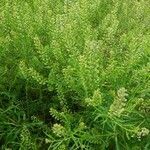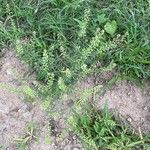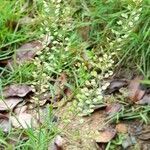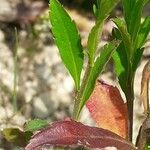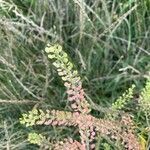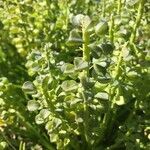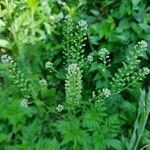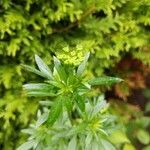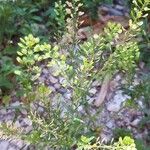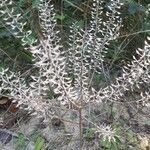Herbs annual or biennial, (6-)15-55(-70) cm tall, pubescent with curved, usually subappressed trichomes. Stems erect, branched above. Basal leaves with petioles 0.5-3.5 cm; leaf blade obovate, spatulate, or oblanceolate, (1-)2.5-10(-15) × 0.5-3(-5) cm, margin pinnatifid or lyrate; lobes oblong, serrate or dentate, apex acute. Cauline leaves shortly petiolate; leaf blade oblanceolate or linear, 1-6 cm × (2-)5-10 mm, base attenuate to subcuneate, margin serrate or entire, apex acute. Infructescence lax or rarely dense; puberulent with curved, subappressed trichomes. Fruiting pedicels slender, straight, spreading, 2.5-4(-6) mm, usually glabrous abaxially. Sepals oblong, (0.5-)0.7-1(-1.1) × 0.5-0.7 mm, margin and apex white, pilose outside. Petals white, spatulate, 1-1.5(-2) × 0.2-0.6 mm, base attenuate, apex rounded, rarely rudimentary. Stamens 2; filaments 0.6-0.8 mm; anthers 0.1-0.2 mm. Fruit orbicular, 2.5-3.5(-4) mm in diam., narrowly winged apically, apex emarginate; apical notch 0.2-0.5 mm; style 0.1-0.2 mm, included in apical notch. Seeds reddish brown, ovate-oblong, usually narrowly winged at least distally, 1.3-1.7(-1.9) × 0.7-1 mm; cotyledons accumbent. Fl. Apr-Jun, fr. May-Sep. 2n = 32*.
Annual or biennial herbs up to 75 cm high. Stems minutely puberulous. Basal leaves rosulate, lyrate-pinnatipartite, frequently dying off before flowering. Lower stem leaves petiolate, oblanceolate or narrowly obovate, the blade sharply serrate and with some small lobes in the lower half. Upper stem leaves oblanceolate, entire or with a few small lobes; all leaves puberulous. Racemes terminal, later apparently leaf-opposed. Pedicels slender, straight, wide-spreading, 4-5.5 mm long in fruit. Sepals 1 mm long, oblong, green, margin membranous. Petals 1.2-1.5 mm long, spathulate to narrowly obovate, clawed, white. Stamens 2; filaments subulate. Nectaries small, triangular-rounded. Siliculae 3-3.5 x 2.8-3.5 mm, subcircular or broadly obovate, emarginate with small apical wings; style very short, included in the sinus. Seeds c.1-25 x 0-75 mm, ovoid, narrowly winged along the outer margin.
Annual or short-lived perennial herb with taproot, 20-80 cm high with one to few erect-ascending stems, branching above, puberulent with thin falcate hairs. Leaves membranous, lowest ones lyrate-pinnatifid, up to 7 cm long, median and upper ones mostly oblanceolate, acutely serrate. Racemes terminal with minute flowers, rather dense in fruit, up to 15 cm long; pedicels in fruit 3.5-5.5 mm long, patent, straight, glabrous. Sepals greenish, c. 1 mm long. Petals white, longer or shorter than sepals, very narrow. Stamens 2 (median) with triangular nectaries. Ovary elliptic, emarginate, style not projecting. Siliculae wingless, suborbicular, 3-3.5 by 2.7-3.5 mm, rather widely and deeply emarginate; style short with stigma completely contained within sinus. Seeds narrowly winged, red-brown, c. 1.5 by 0.9 mm.
Annual; stems freely branched, 1.5-6 dm. high, sparsely pubescent above with minute trichomes; lower leaves irregularly toothed to pinnately divided; upper leaves oblanceolate, acute, irregularly toothed or serrate to almost entire, cuneate at base, becoming smaller upward; racemes numerous and many-flowered; sepals glabrous to sparsely pubescent, ca. 1 mm. long; petals white, slightly exceeding the sepals; stamens usually 2; fruiting pedicels terete, divaricately ascending to spreading at right angles, glabrous or nearly so, somewhat longer than the fruits; siliques glabrous, orbicular to slightly longer than broad, 2.5-3.5 mm. long, shallowly notched at apex; style included in the shallow notch; seeds wingless; cotyledons accumbent.
Annual. Stem erect, shortly hairy, sometimes glabrous below, branched above, 15-40-(100) cm tall. Basal lvs pinnatifid or pinnate with oblanceolate toothed lobes, densely hairy, 5-10 × 1-3 cm. Stem lvs simple; middle lvs oblanceolate, coarsely toothed; uppermost lvs linear, becoming entire, 15-60-(80) × 2-10-(20) mm, with sparse hairs on midrib and margins. Racemes 5-10 cm long; rachis minutely hairy; pedicel minutely hairy, spreading, 3-4-(5) mm long at fruiting. Sepals glabrous, 0.5-1 × c. 0.5 mm. Petals white, obovate-spathulate, > sepals. Stamens 2-4. Silicle circular, 2.5-3 × 2.8-3.2 mm; style free from the narrow wing, not protuding beyond the short apical notch; valves glabrous. Seeds brown, ovoid, winged, c. 1.5 mm long.
Annual or biennial herb 30–50 cm high; erect to decumbent, hairy. Basal leaves lyrate to pinnate, to 9 cm long, hirsute with short curved hairs; cauline leaves reducing to simple, serrate to entire, the margins ciliate. Inflorescence a dense elongated raceme. Sepals 0.7–1 mm long. Petals up to twice as long as sepals, 1–2 mm long, white. Stamens 2, rarely 3 or 4. Stigma subsessile. Silicula dehiscent, broadly ovate to circular, 3–4 mm long, 2.5–3.5 mm wide, glabrous; wings slight in upper half forming shallow open notch; pedicels 4–5 mm long, puberulous on adaxial surface, spreading. Seeds 1.2–2 mm long; radicle accumbent.
Erect annual or biennial 1–5 dm; basal lvs oblanceolate, sharply toothed to pinnatifid or even bipinnatifid; upper lvs smaller, oblanceolate to linear, dentate to entire, acute, narrowed to the base; racemes numerous, to 1 dm; pet equaling to twice as long as the sep; stamens 2; fr broadly elliptic to orbicular, widest at or below the middle, 2.5–4 × 2–3.5 mm, narrowly winged across the tip; style included in the notch; 2n=32. Dry or moist soil, fields, gardens, roadsides, and waste places; Nf. to Fla., w. to the Pacific states. Our plants, with accumbent cotyledons, are var. virginicum.
A cabbage family herb. It is an annual plant. It grows 30-50 cm high. The leaves near the base are lyre shaped and can have lobes. These can be 8 cm long. They are rough with short bristles. The leaves on the stems are simple and have sharp teeth. The fruit is a pod 3 mm long and 3 mm wide. It is almost round but with a notch at the end.
Annual or biennial herb up to 0.75 m high. Basal leaves lyrate-pinnatifid, usually dying off before flowering; upper leaves oblanceolate or narrowly obovate, serrate. Siliculae emarginate, with small apical wings. Flowers whit.
